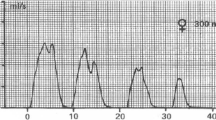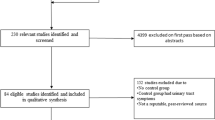Abstract
Introduction and hypothesis
The pathophysiology of stress urinary incontinence (SUI) is multifactorial. The aim of this study was to explore the factor determining the symptom severity of SUI.
Methods
One hundred twenty-four women with SUI were retrospectively investigated. Clinical data for analyses included demographics, pelvic organ prolapse quantification, SUI severity using a 4-point Likert scale, ultrasound, 1-h pad tests, and urodynamic studies. Data were analyzed using the Spearman's rho test and Kruskal–Wallis test.
Results
The symptom severity was not correlated with risk factors of SUI or the morphologic manifestations representing urethral support defect, but was significantly correlated with urine loss on 1-h pad test, Valsalva leak point pressure (VLPP) grading, and maximum urethral closure pressure (MUCP). Women with higher SUI severity had greater urine loss on 1-h pad tests, worse VLPP grading, and lower MUCP.
Conclusions
Urethral sphincter function appears to be an important determinant for the symptom severity of SUI.
Similar content being viewed by others
Abbreviations
- ICS:
-
International Continence Society
- MUCP:
-
Maximum urethral closure pressure
- POP-Q:
-
Pelvic Organ Prolapse Quantification System
- SUI:
-
Stress urinary incontinence
- UPP:
-
Urethral pressure profilometry
- USI:
-
Urodynamic stress incontinence
- VLPP:
-
Valsalva leak point pressure
- rUD:
-
Urethral distance at rest
- rUA:
-
Urethral angle at rest
- sUD:
-
Urethral distance with strain
- sUA:
-
Urethral angle with strain
References
Abrams P, Cardozo L, Fall M, Griffiths D, Rosier P, Ulmsten U et al (2004) The standardisation of terminology in lower urinary tract function: report from the standardisation sub-committee of the International Continence Society. Urology 61:37–49
Whiteside JL, Walters MD (2007) Pathophysiology of stress urinary incontinence. In: Walters MD, Karram MM (eds) Urogynecology and reconstructive pelvic surgery. Mosby, Philadelphia, pp 157–164
Daneshgari F, Moore C (2006) Advancing the understanding of pathophysiological rationale for the treatment of stress urinary incontinence in women: the “trampoline theory”. BJU Int 98:8–14
McGuire EJ, Lytton B, Pepe V, Kohorn EI (1976) Stress urinary incontinence. Obstet Gynecol 47:255–264
Lewicky-Gaupp C, Wei JT, DeLancey JOL, Fenner DE, McGuire EJ, Morgan DM (2008) The association of Incontinence Symptom Index scores with urethral function and support. Am J Obstet Gynecol 199:680e1–680e5
Petros PE, Ulmsten UI (1993) An integral theory and its method for the diagnosis and management of female urinary incontinence. Scand J Urol Nephrol Suppl 153:3–93
Yalcin I, Viktrup L (2007) Comparison of physician and patient assessments of incontinence severity and improvement. Int Urogynecol J Pelvic Floor Dysfunct 18:1291–1295
Albo M, Wruck L, Baker J, Brubaker L, Chai T, Dandreo KJ, for the Urinary Incontinence Treatment Network et al (2007) The relationships among measures of incontinence severity in women undergoing surgery for stress urinary incontinence. J Urol 177:1810–1814
Richter HE, Burgio KL, Brubaker L, Moalli PA, Markland AD, Mallet V et al (2005) Urinary Incontinence Treatment Network. Factors associated with incontinence frequency in a surgical cohort of stress incontinent women. Am J Obstet Gynecol 193:2088–2093
Gasquet I, Tcherny-Lessenot S, Gaudebout P, Bosio Le Goux B, Klein P, Haab F (2006) Influence of the severity of stress urinary incontinence on quality of life, health care seeking, and treatment: a national cross-sectional survey. Eur Urol 50:818–825
DeLancey JO, Trowbridge ER, Miller JM, Morgan DM, Guire K, Fenner DE et al (2008) Stress urinary incontinence: relative importance of urethral support and urethral closure pressure. J Urol 179:2286–2290
Huang WC, Yang JM (2003) Bladder neck funneling on ultrasound cystourethrography in primary stress incontinence: a sign associated with urethral hypermobility and intrinsic sphincter deficiency. Urology 61:936–941
Huang WC, Yang SH, Yang JM (2006) Anatomical and functional significance of urogenital hiatus in primary urodynamic stress incontinence. Ultrasound Obstet Gynecol 27:71–77
Yang SH, Huang WC, Yang SY, Yang E, Yang JM (2009) Validating new ultrasound parameters for quantifying pelvic floor muscle contraction. Ultrasound Obstet Gynecol 33:465–471
Melville JL, Miller EA, Fialkow MF, Lentz GM, Miller JL, Fenner DE (2003) Relationship between patient report and physician assessment of urinary incontinence severity. Am J Obstet Gynecol 189:76–80
Bump RC, Mattiasson A, Bø K, Brubaker LP, DeLancey JO, Klarskov P et al (1996) The standardization of terminology of female pelvic organ prolapse and pelvic floor dysfunction. Am J Obstet Gynecol 175:10–17
Yang JM, Yang SH, Huang WC (2008) Dynamic interaction involved in the tension-free vaginal tape obturator procedure. J Urol 180:2081–2087
Nitti VW, Combs AJ (1996) Correlation of Valsalva leak point pressure with subjective degree of stress urinary incontinence in women. J Urol 55:281–285
Almeida FG, Bruschini H, Srougi M (2005) Correlation between urethral sphincter activity and Valsalva leak point pressure at different bladder distentions: revisiting the urethral pressure profile. J Urol 174:1312–1315
Martan A, Mašata J, Petri E, Švabík K, Drahorádová P, Voigt R et al (2007) Weak VLPP and MUCP correlation and their relationship with objective and subjective measures of severity of urinary incontinence. Int Urogynecol J Pelvic Floor Dysfunct 18:267–271
Ku JH, Shin JW, Oh SJ, Kim SW, Paick JS (2006) Clinical and urodynamic features according to subjective symptom severity in female urinary incontinence. Neurourol Urodyn 25:215–220
Theofrastous JP, Bump RC, Elser DM, Wyman JF, McClish DK (1995) Correlation of urodynamic measures of urethral resistance with clinical measures of incontinence severity in women with pure genuine stress incontinence. The Continence Program for Women Research Group. Am J Obstet Gynecol 173:407–414
Chen CCG, Rooney CM, Paraiso MF, Kleeman SD, Walters MD, Karram MM et al (2008) Leak point pressure does not correlate with incontinence severity or bother in women undergoing surgery for urodynamic stress incontinence. Int Urogynecol J Pelvic Floor Dysfunct 19:1193–1198
Rud T (1980) Urethral pressure profile in continent women from childhood to old age. Acta Obstet Gynecol Scand 59:331–335
Petros PE (2003) Changes in bladder neck geometry and closure pressure after midurethral anchoring suggest a musculoelastic mechanism activates closure. Neururol Urodyn 22:191–197
Petros PE, Woodman PJ (2008) The Integral theory of continence. Int Urogynecol J 19:35–40
Petros PE, Ulmsten U (1997) Role of the pelvic floor in bladder neck opening and closure: I muscle forces, II vagina. Int J Urogynecol Pelvic Floor 8:69–80
Petros PE, Von Konsky B (1999) Anchoring the midurethra restores bladder neck anatomy and continence. Lancet 354:997–998
Fritel X, Fauconnier A, Pigné A (2008) Circumstances of leakage related to low urethral closure pressure. J Urol 180:223–226
Acknowledgements
This study was supported by grants from the National Science Council (NSC 97-2314-B-195-012-MY3 and NSC 97-2314-B-281-003-MY2).
Conflicts of interest
None.
Author information
Authors and Affiliations
Corresponding author
Rights and permissions
About this article
Cite this article
Yang, JM., Yang, SH., Yang, SY. et al. Clinical and pathophysiological correlates of the symptom severity of stress urinary incontinence. Int Urogynecol J 21, 637–643 (2010). https://doi.org/10.1007/s00192-009-1094-4
Received:
Accepted:
Published:
Issue Date:
DOI: https://doi.org/10.1007/s00192-009-1094-4




